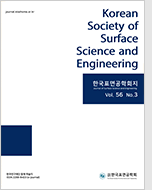
- Past Issues
- e-Submission
-

2021 Impact Factor 1.766
5-Year Impact Factor 1.674
Editorial Office
- +82-2-563-0935
- +82-2-558-2230
- submission@kssse.or.kr
- https://www.kssse.or.kr/

2021 Impact Factor 1.766
5-Year Impact Factor 1.674
The Korean Society of Surface Science and Engineering 2023;56(4):250-258. Published online: Aug, 30, 2023
DOI : https://doi.org/10.5695/JSSE.2023.56.4.250
Ceramic oxide layer was formed on the surface of high silicon aluminum alloy by using PEO (plasma electrolytic oxidation) process. The microstructure of the oxide layer was analyzed using scanning electron microscopy (SEM) and x-ray diffraction patterns (XRD). The high silicon aluminum alloy prior to PEO process consists of Al, Si and Al2Cu phases in XRD analysis, whereas Al2Cu phase selectively disappeared after PEO treatment. Considerable decrease of relative intensity in most of peaks in XRD results of the high silicon aluminum alloy treated by PEO process was observed. It may be attributed to the formation of amorphous phases after PEO treatment. The corrosion behavior of the high silicon aluminum alloy treated by PEO process was investigated using electrochemical impedance spectroscopy (EIS) and other electrochemical techniques (i.e., open circuit potential and polarization curve). Electroanalytical studies indicated that the high silicon aluminum alloy treated by PEO process shows greater corrosion resistance than that untreated by PEO process.
Keywords Electrochemical process; plasma electrolytic oxidation; corrosion behavior; high silicon aluminum alloy; ceramic oxide layer.